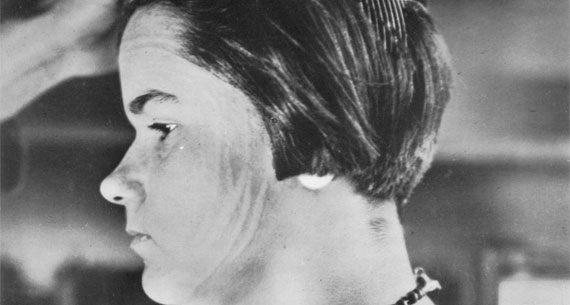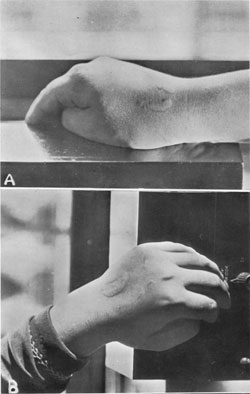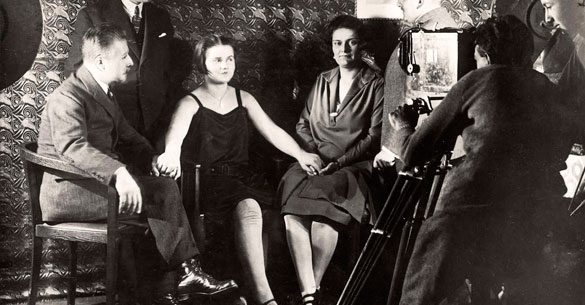
|
|||
Eleonore Zugun - The Romanian 'Poltergeist Girl'
Source : http://listverse.com
Poltergeist's, telekinesis, stigmata, exorcism and supernatural phenomena, are as mysterious and as fascinating today as they have been to people many centuries ago. As yet we can not prove that such events are accurate or true, however neither can we disprove them with absolute certainty either. Eleonore Zugun was born in a small Romanian village called Talpa in 1914 and the first 12 years of her life were pretty ordinary and uneventful. However before she reached her teenage years she moved to Buhai, also in Romania, to go to live with her grandparents. Before long strange and unexplained phenomena began to happen around the young girl and as news began to spread amongst the people of the village, she became known as the 'Devil girl' and the 'poltergeist girl'. Legend has it that inanimate objects would seemingly move unaided and land on the floor close to where Eleonore sat or stood. Rocks and china would get thrown through the windows of her grandparents cottage in great showers of shrapnel. During one notable occasion a priest had came to visit the troubled household, he picked up a whet stone that had been an object of such an attack, branded it with the sign of the cross, blessed it and throw it into a near by river. It is said that the same stone, not more then an hour later, was launched back into the building. Gossip, stories and speculation continued to escalate and the rumors surrounding Elenore Zugun, soon began to travel beyond Romania. As the abnormal activity continued and as the situation became more and more difficult to deal with, in desperation, Eleonore was incarcerated in an asylum. Sent to a convent where she was put into confinement. She also went through an attempted exorcism, but all to no avail. It appeared for a time that there was nothing more that could be done for the poor girl, and she would be left with the plight of being an outcast for the rest of her living days. Which not only was affecting herself, but her relatives as well. Psychical research had become a past time for Countess Zoe Wassilko-Serecki, who had heard of Eleonore's extraordinary story and experiences. Intrigued and convinced enough of it's authenticity she decided to look after Eleonore, and took her back to her flat in Vienna. She wanted to study her further and try to discover more about the unexplainable incidents that seemed to be happening to and around her. Born on 24 May 1913, Eleanore Zugun was a Rumanian peasant girl who lived in the village of Talpa, in the north of the country. In February 1923, when she was eleven years old, she went to visit her grandmother’s house at Buhai, a few miles away from her village. On the way she found some money by the side of the road, and when she arrived at Buhai she spent it on sweets and ate them all. Her 105-year-old grandmother, who had the reputation of being a witch, overheard Eleonore and her cousin arguing about the sweets, and warned her that the devil (Dracu in Rumanian) had left the money to tempt her, and from then on she would never be free of him. The next day poltergeist activity began. Stones crashed against the house and broke windows, and small objects near to Eleonore jumped up and flew about. Her superstitious grandmother was convinced that the girl was possessed and Eleonore was quickly sent home to Tulpa. But here, three days later, the poltergeist started again. A jug full of water rose slowly into the air and floated several feet without any water being spilled. A trunk shook violently up and down, a porridge bowl flew at a visitor and hit him on the back of the head causing a painful wound. The phenomena continued and Eleonore found refuge in the monastery of Gorovei. But after But after three weeks there, with the violence of the phenomena unabated, she was locked in a lunatic asylum. Fortunately, newspaper accounts of her strange story reached eminent Austrian psychical researcher Fritz Grunweld in Charlottenburg, Germany, who, with the help of Kubi Klein, a journalist form Czernowitz, managed to get her sent back to the monastery where she could be properly observed. Grunewald took detailed shorthand notes of the amazing phenomena which took place between the 9 and 18 of May, 1925. (These were edited and published after his death by Professor Christoph Schröder in the Zeitschrift für psychische Forschung, vol. I, 1927.) The most common type of phenomenon were object -movements, ranging from the slow movement of a large pot on the oven, to the sometimes violent throwing of things at or close to people. Objects also appeared seemingly from nowhere (apports), and there were occasional knocks, and, once or twice, matches were mysteriously set alight. The poltergeist also began slapping the girl. In July 1925, however, Grunewald died of a heart attack aged forty-one, and the unlucky Eleonore was once again left in the care of her apparently unconcerned family. Fortunately, later that year, she found another protector.
Most interesting were the very rare cases when the last part of the hypothetical line of flight of a moving object was to be observed. Once I entered my room and looked at the window. Eleanore was standing behind me. Suddenly I saw a shadow which glided down slowly in front of the window and not straight, but in a zigzag line . . . Then I heard a low sound of something falling. I looked and saw a little iron box filled with dominoes. The box was closed but some of the dominoes lay next to it on the floor . . . Another time I was sitting with Mr. Klein at the round table, while Eleonore stood with a cat in her arms at the book-stand. Mr. Klein unintentionally looked at the girl, and on this occasion noticed a dark grey shadow come from behind her, pass along her right side and fall under our table upon the cushions at our feet. It was a tin box which had before stood on the washstand on the other side of the room. I had always the impression that a returning object of the kind was only again submitted to the normal laws of the physical world when it was perfectly itself again . . . The foregoing shadow has nothing at all to do with the appearance of the object itself. I think that the impression which this moving riddle makes, is described best by the words: ‘Hole in the World’, which I used for it.  Occasionally raps on furniture were also heard in Eleonore’s presence, and, very rarely, independent voices. Cherished possessions disappeared and were sometimes never seen again; or if they were returned, were broken or damaged. But the most significant and persistent development at this time was the occurrence of numerous physical assaults on Eleonore’s body by the malicious ‘Dracu’. And here the parallels with the tragic case of Maria José Ferreira are obvious. Objects were violently hurled at Eleonore, she was slapped, forced to the ground, tossed out of bed, had her hair yanked out and her shoes filled with water. As if this wasn’t enough, from late March 1926, things got even worse. The girl’s hands and fingers were constantly pricked as if by needles, and sometimes real needles were found embedded in her flesh. On 30 April 1926, Harry Price, the well known and controversial English psychical researcher, arrived in Vienna. He was much interested in thirteen-year-old Eleonore’s case and visited the Countess’s flat on three occasions. While there he witnessed object-movements such as a steel letter-opener fly across the room, a small mirror float over the partition of a room, and a cushion move off a chair whilst he had both the Countess and Eleonore in view. He also observed bite and scratch marks appear on Eleonore’s arm and chest, and a large black cloth dog appear from nowhere. Price was impressed and convinced that some of the telekinetic phenomena (i.e. object-movements) he witnessed could not be explained by normal means. He decided to bring the Countess and Eleanore to London for study at the National Laboratory of Psychical Research, an institution largely created and run by himself. They arrived in London on 30 September 1926, and stayed until 14 October. Eleonore’s visit produced great interest in the British Press and large headlines, innumerable articles, photographs, and cartoons were dedicated to Harry Price’s new ‘discovery’. Eleonore spent many hours at the Laboratory sometimes alone and sometimes with the Countess. Physical lacerations in the form of bite and scratch marks occurred in ordinary daylight when Eleonore was under close observation and some of these ‘stigmatic’ markings were photographed by Price. However, Price was more impressed by the object-movements which occurred in the vicinity of the young Rumanian girl. Though two possible attempts at cheating were noticed, telekinetic phenomena were convincingly demonstrated, and their authenticity was attested by various prominent observers. The most amazing of these incidents was when a small metallic letter C, from the spare stock used for a notice board in the Laboratory, disappeared from a securely locked cupboard. Eleven days later it was found by Professor Tillyard F.R.S. – in the strangest of places. It was fastened tightly around the metal rim of his pocket knife case, sealing it shut. Professor Tillyard had used the knife more than once that day and the metallic letter had not been there when he did. Trickery was not possible as close control of Eleonore and the Countess was operated in the Laboratory at all times. This incident helped to convince many of the scientists and doctors invited by Price to observe the little Rumanian girl that they had witnessed authentic paranormal phenomena.  Price and the Laboratory Council concluded that with Eleanore they had indeed shown ‘that under scientific test conditions movements of small objects without physical contact undoubtedly took place’. Late in October Eleonore and the Countess left London for Berlin. After she returned from England Eleonore’s telekinetic ability began to fade, but the biting and scratching continued, with one important and unpleasant new element – the appearance on her skin of large amounts of saliva. There are other cases of biting and scratching poltergeists and one – that which occurred in Bristol in1761-2 – where foul-smelling spittle was found in some of the bite-wounds of the young female victims. Samples of this spittle taken from Eleonore’s arm and face were analyzed and found to be full of micro-organisms, whereas that taken from Eleonore was relatively free of micro-organisms. Obviously the saliva was not Zugun’s. To test whether the marks on Eleonore’s body were caused from outside of her body, a Dr Walther Kröner smeared her face and arms with greasepaint; on examination it was discovered that that when scratches appeared, the greasepaint had been pushed aside – showing that they were externally created. In January 1927 Eleonore and the Countess left Berlin and spent a fortnight in Munich, as the guest of Baron von Schrenck-Notzing. A cine-film of the ‘friend of Dracu’, as she was dubbed, in action was made at one of the sittings there by the Emelka-Kultur-Gesellschaft (‘Eku’ company), a copy of which is held by the British Society for Psychical Research. One of the things shown in the film is Eleonore’s arms being held by researchers whilst she cringes in apparent pain.; close-up shots show bite marks which had seemingly just appeared. Dr. Hans Rosenbusch, a Munich doctor who had been present at two of the sittings, invited Eleonore and the Countess to give a sitting in his own home. Shortly afterwards, he announced that he had found Eleonore cheating with the help of the Countess, and declared the girl a fake. Harry Price replied that, though the girl would probably cheat if allowed, all of his test experiments with her were tightly controlled and the Countess was not present at any of them, and still unexplained phenomena occurred.  Many prominent Viennese scientists and doctors also declared themselves convinced of the phenomena they had witnessed for six months in the presence of Eleonore. The Countess came to her own and Eleonore’s defence, saying that she told Rosenbusch Eleonore would probably cheat if allowed. She sued Rosenbusch for libel, but the case was eventually dismissed on technical grounds. Rosenbusch’s case remains unproven, and it must be noted that he completely ignored the genuinely unexplainable phenomena which occurred when no trace of fraud was detected. As well as this, later analysis of the documentary film taken in Munich showed no indication of fraud. The controversy became irrelevant when, in the early summer of 1927, around the time of her fourteenth birthday and the onset of menstruation, Eleonore’s phenomena ceased for good. When last heard of, in the 1930s, she was running a successful hairdressing business in Czernowitz, Rumania. As far as explanations for the Eleonore Zugun case are concerned, the Countess Wassiliko-Serecki herself was convinced that Eleonore’s unconscious mind was responsible for the attacks. Obviously influenced by Freud, she believed that Eleanore had strongly developed sexual urges, partly centered on her father, and the ‘attacks’ were a kind of self-punishment for these feelings. Harry Price agreed and compared the bites and scratches to the ‘stigmata’ found on some religious people. However, as Colin Wilson points out, carrying this form of self punishment on for two years, much of this spent in comfortable security with the Countess, seems unlikely to say the least. The threats of her grandmother and the peasants of her village regarding ‘Dracu’ and what he would do to her must certainly be born in mind when thinking of the subconscious origins of Eleonore’s poltergeist. But even if this is taken as probable, where did the power come from to throw objects around and make them disappear in one room and re-appear in another? Or to generate scratch and bite marks that contained saliva that was not her own? Was it an independent mischievous entity, or some unsuspected and bizarre part of the human personality of which we know practically nothing? Submit News/Videos/Links | Discuss article | Article Link | More Unsolved and Unexplained Mysteries |
More can be addded on request. Direct your requests at vinit@theunexplainedmysteries.com
